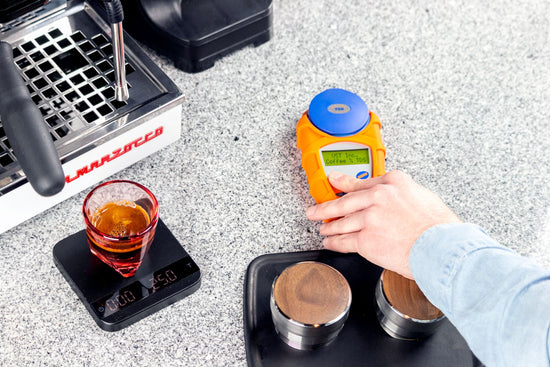What is Extraction?

If you listen to coffee professionals talk about the brewing process you’ll often hear the word extraction crop up. Sometimes it sounds technical, sometimes subjective. Sometimes it refers to a number but sometimes it refers to the way a shot looks while it’s pulling. These seemingly mixed messages can make it hard to suss out what it’s really supposed to mean.
Extraction as a word simply refers to the act of taking something out. In the case of coffee, the “extracting” that we’re referring to is the act of pulling soluble compounds out of coffee beans by using water. Pretty simple. Where it gets tricky is that people use the word extraction to refer to both the way in which a thing was extracted as well as to describe the thing that was extracted. Today, we’ll just be talking about the latter, using the word to describe the stuff that we extract from coffee.
For instance, if you’re pulling a shot the extraction is all of the stuff that was in the grounds in our portafilter basket that’s now in the cup. The amount of dissolved solids in that cup in proportion to the amount of water represents the strength of our coffee. If there were more dissolved solids in that same volume of water it would be a stronger cup of coffee. We can measure this by using a device called a refractometer which shines a laser through a sample of our coffee to determine what percentage of the sample is dissolved solids.
Now, knowing the strength of our coffee is somewhat handy. Far more useful is calculating our extraction percentage. This is the weight of the dissolved solids in our coffee as a percentage of the weight of the dose we used to brew it. This is a weird way of talking about coffee if you haven’t worked on calculating extraction before – to help explain, let’s imagine that after we pulled a shot of espresso we boiled our shot until all the water had evaporated off and all we had left was the coffee solids that were previously floating in that water. All of that dust originally came from the coffee grounds we put in our portafilter. If we weigh that dust and express it as a percentage of our 20g dose that’s our extraction percentage – the amount of material we extracted from our coffee grounds and got in our cup. At a glance, this may seem like a somewhat arbitrary measurement but it turns out to be one of the most powerful measurements in the world of coffee.
About 30% of the weight of any given coffee bean is soluble. In that 30%, you have a variety of different compounds that can be salty, sweet, savory, and bitter. Each coffee’s unique collection of compounds is what lends it its unique flavor. What’s most notable is that over the course of any extraction these compounds dissolve in a consistent order – from salty to sweet to bitter.
Research over the past few decades has shown that for all coffees, roast levels, and brew methods people nearly unanimously prefer their coffee to have an extraction between 18% and 22%. This has been shown to be true for people from around the world. With that in mind, you can probably see why extraction percentage is so powerful: it gives you an objective measurement of whether or not a brew will taste good.
A coffee with an extraction between 18% and 22% is considered to be properly extracted. This is where the terms over and under-extracted come from. If you’ve ever had a coffee that’s overwhelmingly sour or salty it likely had an extraction well below 18%. When you taste coffee that’s bitter and maybe even woody it likely has an extraction above 22%.
As nice as it is to be able to calculate extraction percentage, refractometers are pricey tools. They’re really useful in a commercial or lab environment, but they’re not necessary for every home barista. It may not be as objective but your tongue is great at giving you this same information. With a solid understanding of what extraction means you’re far better equipped to listen to your tongue and adjust your brew recipe accordingly.